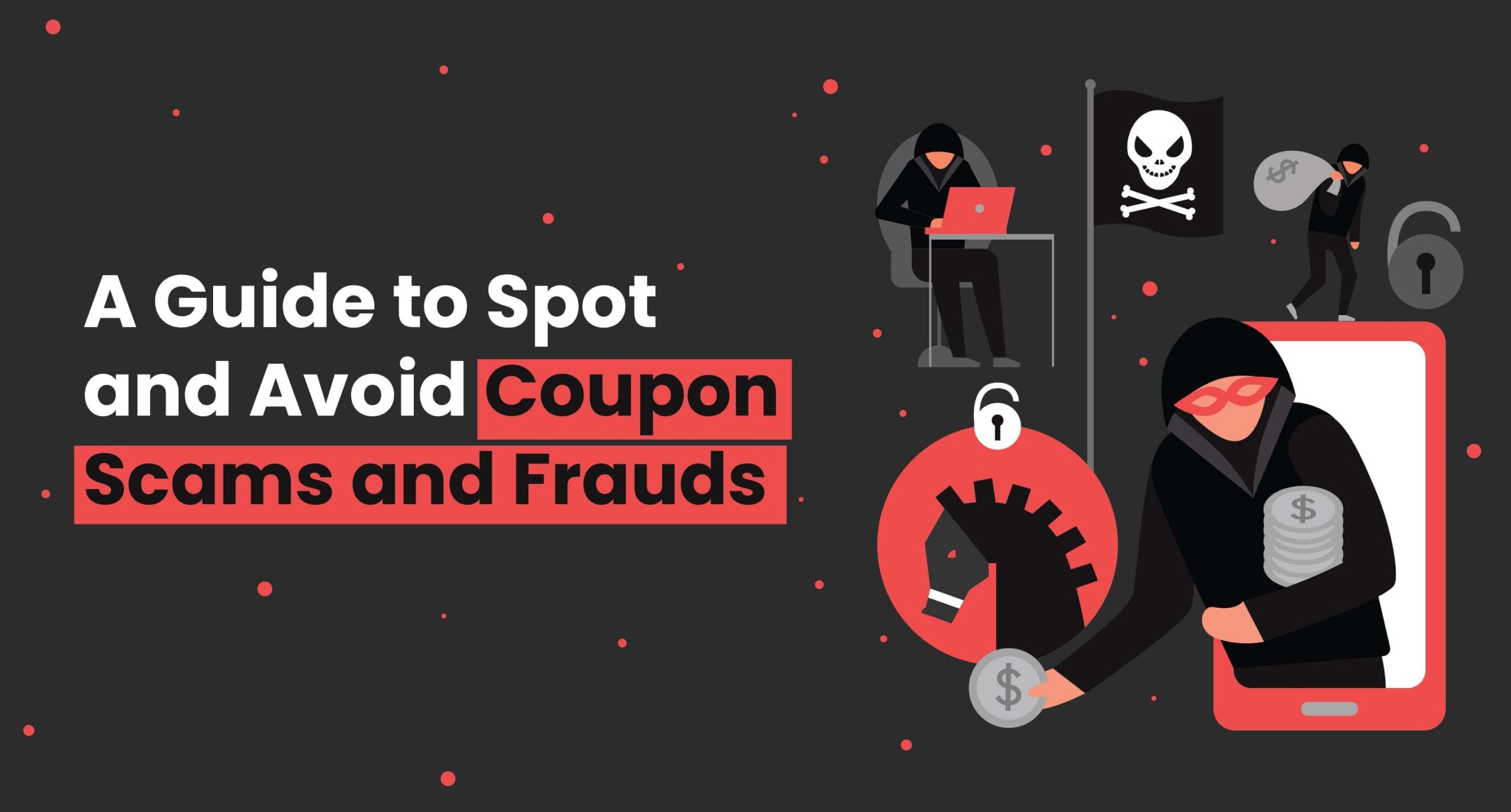A Guide to Spotting and Avoiding Coupon Scams and Frauds


Imagine the excitement of being armed with your trusty coupons, ready to score incredible deals at your favorite store. But amidst the thrill, hidden in the shadows, lie cunning scammers and fraudsters, eagerly waiting to prey on unsuspecting coupon enthusiasts like yourself. They’re experts in deception, inventing clever schemes to drain your hard-earned money and leave you feeling like a gullible victim.
But fear not! We’re here to empower you with the knowledge to outsmart these coupon predators. Together, we’ll uncover the world of counterfeit coupons, phishing scams, and pyramid schemes. So, join us on this journey as we reclaim the joy of couponing and outsmart those who seek to exploit our savings.
What is Coupon Misuse?
Coupon misuse refers to the improper or unauthorized use of coupons in a manner that violates the terms and conditions set by the issuing company. It involves actions that go against the intended purpose or restrictions placed on the use of coupons. Coupon misuse can include various practices, such as:
Violating coupon terms: This involves disregarding the specific terms and conditions stated on the coupon. For example, if a coupon specifies a minimum purchase requirement or restricts the use to certain products or services, coupon misuse occurs when these conditions are not met or are intentionally bypassed.
Exploiting coupon limitations: Companies often impose restrictions on coupon usage, such as limiting one coupon per customer, per transaction, or per household. The misuse occurs when individuals or customers attempt to circumvent these limitations by using multiple coupons, creating fake accounts, or using false identities to redeem the same coupon multiple times.
Sharing coupons improperly: Coupons are often meant for personal use and should not be shared with unauthorized individuals or publicly distributed beyond the intended audience. The misuse is recorded when individuals excessively share coupons through unauthorized channels, such as posting them on coupon forums, and social media platforms, or distributing them to individuals who are not eligible for the offer.
Using expired coupons: Expired coupons are no longer valid and should not be redeemed. This form of misuse happens when individuals knowingly attempt to use coupons after their expiration dates, seeking discounts or benefits that are no longer applicable.
Unauthorized coupon code generation: Some individuals may attempt to generate or guess coupon codes without proper authorization. This can involve using automated tools or algorithms to generate codes in an attempt to exploit the system or obtain unauthorized discounts.
Abusing affiliation programs: Affiliate programs allow individuals to earn commissions or rewards by referring customers to a business. The abuse of coupons can occur when fraudsters create fake referrals or manipulate the system to gain undeserved benefits or rewards.
Abusing possible loopholes in a given campaign: Coupon abusers may meticulously examine the terms and conditions of a campaign to identify loopholes or ambiguous clauses. They exploit these weaknesses to gain benefits or discounts that were not intended by the company running the campaign.
Sending fake complaints to obtain a promo code: Fraudsters may submit fake complaints or provide false negative feedback to customer support in order to obtain a promo code as compensation. This manipulative tactic seeks to exploit the company’s goodwill and compensation policies.
Excessive discount stacking: Coupon stacking refers to combining multiple coupons or discounts on a single purchase. Abusers may attempt to stack numerous coupons or exploit loopholes in the terms and conditions to maximize their discounts beyond what is intended by the offer.
How to combat coupon fraud and abuse?
To safeguard yourself from falling victim to coupon scams and frauds, it’s important to take proactive measures and follow these practical steps:
1. Generate hard-to-crack codes:
It’s all about making those coupon codes as elusive as a ninja. Create complex and unique codes that are difficult to guess or replicate. No more easy-peasy codes like “12345” or “DISCOUNT50”! Be creative and mix it up.
Example: Instead of using a simple code like “SUMMER25,” opt for something like “SUNSH1N3_2023!”
2. Limit the number of coupon redemptions:
To prevent the coupon hoarders from getting away with endless discounts, set a cap on the number of times a coupon can be redeemed. Let’s keep it fair for everyone, shall we?
Example: Allow customers to redeem a specific coupon code only once per transaction or per customer account.
3. Control the coupon activity period:
Time is of the essence, my friend! Set an expiration date for your coupons to prevent people from using them long after their expiry date. Keep those discounts fresh and within a reasonable timeframe.
Example: Create a coupon that expires 30 days from the day it was issued, giving customers enough time to use it while avoiding abuse.
4. Assign unique codes to single customer profiles:
Personalize those coupons like a handwritten love letter! Assign unique coupon codes to individual customers to ensure they can’t be shared or used by someone else. It’s like giving each customer their own secret passcode.
Example: Generate a unique coupon code for each registered customer or tie it to their email address.
5. Introduce budget limits:
Don’t let coupon abusers go on a spending spree! Set budget limits on the total discount amount that can be applied per transaction or customer. It helps maintain control and prevents excessive discounts.
Example: Allow a maximum discount of $50 per transaction or limit the total discounted amount a customer can avail of during a specific time period.
6. Use cart- and order-based coupon redemption criteria:
Get strategic and tie those coupons to specific criteria. Offer discounts based on the contents of the shopping cart or the total order value. Make them work for it!
Example: Provide a 10% discount if the cart value exceeds $100 or offer free shipping for orders with three or more items.
7. Introduce email verification for digital offers:
Let’s verify those digital coupon lovers! Require customers to validate their email addresses before they can redeem certain digital offers. It helps ensure they’re legit and not just trying to pull a fast one.
Example: Ask customers to confirm their email address by clicking on a verification link before gaining access to the digital coupon.
8. Invest in behavioral analytics to detect suspicious activity:
Who needs Sherlock Holmes when you have behavioral analytics? Use advanced tools to monitor customer behavior and identify any suspicious patterns or anomalies. Catch those fraudsters red-handed!
Example: Analyze customer redemption patterns and flag accounts that exhibit unusually high coupon usage or frequent attempts to manipulate the system.
9. Monitor IP addresses with a web beacon:
Keep an eye on those sneaky IP addresses! Use web beacons to track the IP addresses associated with coupon redemptions. It helps identify any suspicious activity originating from the same IP address.
Example: If multiple coupon redemptions occur within a short time frame from the same IP address, it may indicate abuse or fraudulent behavior.
10. Create geo-located coupons:
Target specific regions or areas with geographically restricted coupons. It helps control coupon distribution and prevents misuse outside the intended target audience.
Example: Create a coupon valid only in a particular city or state, ensuring it reaches the intended local customers.
11. Monitor redemptions to detect suspicious behavior:
Keep a close watch on those redemptions, my friend! Implement systems to monitor and analyze coupon redemptions for any signs of suspicious behavior or excessive usage.
Example: Set up automated alerts or reports to flag accounts with an unusually high number of redemptions or multiple redemptions within a short period.
12. Control the coupon distribution:
Don’t let those coupons run wild! Implement measures to control how and where your coupons are distributed. Avoid unauthorized channels that may attract coupon abusers.
Example: Partner with reputable platforms or limit coupon distribution to specific marketing channels and verified customer databases.
13.Avoid coupon stacking:
One coupon per transaction, please! Clearly state in your terms and conditions that coupons cannot be stacked or combined unless explicitly permitted. It helps prevent people from piling up discounts like a Jenga tower.
Example: Specify that only one coupon can be used per transaction, and multiple coupons cannot be combined unless explicitly stated.
14. Use a staging environment to test coupons:
Before launching your coupons into the wild, give them a test run! Create a staging environment where you can test and validate coupon functionality to ensure they work as intended and aren’t prone to abuse.
Example: Create a separate test environment or sandbox to validate coupon codes and their associated rules before deploying them live.
15. Control access to your promotion software:
Keep the keys to the castle safe and sound! Limit access to your promotion software and coupon management systems to authorized personnel only. It prevents unauthorized changes or misuse of coupon settings.
Example: Restrict access to coupon management systems to specific individuals within your organization who are responsible for coupon creation, monitoring, and validation.
Reporting Coupon Scams and Frauds
Reporting coupon scams and frauds is crucial in protecting yourself and others from falling victim to fraudulent activities. By reporting these incidents, you help authorities take action against scammers and raise awareness to prevent further harm. Here’s how and where you can report coupon scams and frauds:
1. Consumer Protection Agencies:
Contact your local consumer protection agency or consumer affairs office. These agencies are dedicated to safeguarding consumers’ interests and combating fraudulent practices. They can provide guidance on reporting coupon scams and frauds specific to your region and may investigate the reported incidents.
2. Federal Trade Commission (FTC):
The FTC is a U.S. government agency responsible for protecting consumers from unfair and deceptive practices. You can file a complaint with the FTC through their online complaint assistant at ftc.gov/complaint. Provide as much detailed information as possible about the coupon scam or fraud, including any supporting documentation or evidence.
3. Better Business Bureau (BBB):
The BBB is a nonprofit organization that focuses on fostering marketplace trust. You can report coupon scams and frauds to the BBB through their Scam Tracker platform at bbb.org/scamtracker. This helps alert others in your community and provides valuable information for investigations.
4. Internet Crime Complaint Center (IC3):
If you encountered a coupon scam or fraud online, you can report it to the IC3, a partnership between the FBI and the National White Collar Crime Center. Visit their website at ic3.gov to file a complaint related to internet crimes.
5. Social Media Platforms:
If you come across coupon scams or fraudulent activities on social media platforms, report them directly to the respective platform. Most social media platforms have reporting mechanisms to address fraudulent content and accounts. Look for options to report scams, fake profiles, or suspicious coupon offers.
When reporting coupon scams and frauds, gather as much information as possible to support your complaint. This may include screenshots or copies of emails, messages, or any communication related to the fraudulent activity. Provide details about the scammer, their methods, and any relevant information that can aid in the investigation.
Remember, reporting fraudulent activities not only helps protect yourself but also assists in preventing others from becoming victims. Your report can contribute to the efforts of law enforcement agencies, consumer protection organizations, and online platforms in combating coupon scams and frauds.
Done With It!
Coupon scams and frauds pose a significant risk to consumers, but by staying informed and proactive, you can protect yourself from falling victim to these deceptive practices. Stay vigilant and secure yourself with the knowledge to navigate the world of coupons safely. Share the information you’ve learned from this blog with your friends and family, as awareness is the key to preventing coupon scams and frauds.
Frequently Asked Questions
1. What are coupon scams and frauds?
Coupon scams and frauds refer to deceptive practices where individuals or organizations trick consumers into providing personal information, paying for fake coupons, or using unauthorized or counterfeit coupons.
2. How can I spot a coupon scam?
Look out for red flags such as coupons that promise unrealistic discounts, requests for payment or personal information to access coupons, or codes that are poorly designed or contain spelling errors.
3. What should I do if I come across a suspicious coupon?
If you encounter a suspicious coupon, it’s best to avoid using it. Report the coupon to the retailer or coupon issuer, and consider contacting your local consumer protection agency or the Better Business Bureau to notify them of the scam.
4. Are all digital coupons safe to use?
Not all digital coupons are created equal. Stick to reputable sources such as official retailer websites or trusted couponing apps to minimize the risk of encountering fraudulent or unauthorized coupons.
5. Can I trust coupon websites and online forums?
While many coupon websites and online forums provide legitimate offers, exercise caution. Verify the authenticity of the coupons and the reputation of the website or forum before using any coupons shared there.
6. What are some signs that a coupon is legitimate?
Legitimate coupons typically have clear terms and conditions, valid expiration dates, and are issued directly by the retailer or a well-known coupon provider. They are usually free to access and do not require personal or payment information.
7. How can I protect my personal information when using coupons?
Be cautious when coupons request personal information beyond what is necessary for redemption. Avoid sharing sensitive details like your Social Security number or bank account information to protect yourself from identity theft.
8. Can I trust coupons received via email or text message?
Exercise caution when receiving coupons via email or text message, especially if they are unsolicited. Verify the source and legitimacy of the coupon before clicking on any links or providing personal information.



